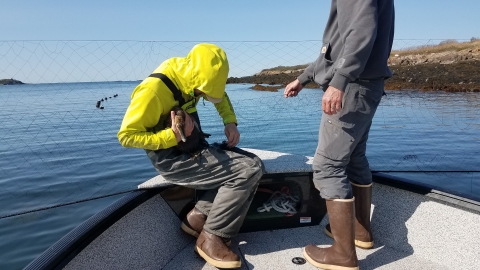ACE Fellow Evan Bartow shares his reflections after his time in the field banding and adding radio transmitters to common eiders in Casco Bay near Harpswell, ME.
Floating in ice-cold water, we slowly drifted behind a pair of common eiders as they swam towards our runway of decoys. Silent aside from the quiet hum of the boat motor, the occasional call of a gull flying overhead, and the sound of the wind pushing us forward, we directed the eiders towards the mist net. Suddenly, the boat jolted forward as we accelerated towards the eiders. This swift movement caused the eiders to fly into the net resulting in the first capture of the day.
Before assisting the Maine Department of Inland Fisheries and Wildlife (Maine DIFW), U.S. Fish & Wildlife Service, and the Biodiversity Research Institute (BRI) with their research on common eiders, I had little experience in the field working with wildlife. In my role as an American Conservation Experience (ACE) Fellow with the Office of Conservation Investment, most of my work takes place at the office working as a liaison between state fish and wildlife agencies and the manufacturers that pay excise taxes. I had never even seen an eider in person, let alone held one. By the end of the week, the team and I successfully banded and added radio transmitters to nearly 30 female common eiders in Casco Bay near Harpswell, ME.
This study, supported by Wildlife Restoration funds from excise taxes paid by manufacturers of firearms, ammunition, and archery equipment, has focused on monitoring the annual changes in eider populations on Flag Island and Little Birch Island to determine potential causes for the decreasing eider population in Maine, specifically, the survival of ducklings to fledging.
For six years, Flag Island’s eider population has been studied due to its prominent nesting habitat, and for the last three years of the study, USDA Wildlife Services has worked to reduce the predation of eider ducklings by great black-backed gulls nesting nearby. The study seeks to evaluate the effectiveness of these efforts in increasing duckling survival in a localized area for a short period of time. Little Birch Island was monitored for the final three years of the study to compare an island with eiders and co-nesting gulls with no management.
On the first day in the field, I worked with the BRI crew at Little Birch Island where we set up the row of decoys and the mist net, untangled caught eiders, and transported the ducks to the crew that was adding bands and transmitters. During this work, I saw firsthand the importance of patience and decisive decision-making while working in the field. Move too fast and the eiders would fly right over the net; move too slow and the eiders would expertly dive or swim around the net. But by patiently following the eiders, followed by a quick acceleration at a distance from the decoys and the mist net, we managed to effectively time our movement which resulted in the capture of many sea ducks.
During the second and third days, I switched to Flag Island where I helped record data and assisted in radio-marking the female eiders. We collected measurements of the eider’s weight, culmen, bill and head length, tarsus, and wing. Specific markers are helpful for biologists in identifying and studying eiders each week during the brood rearing period as the markers are unique to each female that was caught and can inform biologists about how specific hen eiders are associated with broods once the transmitters fall off.
Our next step was to add the radio transmitters to the back of the eiders. Chris Dwyer, wildlife biologist with the Office of Conservation Investment, sutured the transmitters to the hens while I held the ducks in place on the table. On average, the entire biological workup took Chris and I thirty minutes to complete our work on each eider.
Assisting Maine DIFW, USFWS, and BRI with their research on eiders was a rewarding experience. Initially, I was unsure what to expect when they asked me to help with this project, but I was eager to be out in the field and work with a group of dedicated biologists. Their commitment to conservation was evident throughout each conversation we had and the tasks that we completed.
This field work rewarded me with a greater understanding of how Wildlife Restoration funds are used by state agencies, the roles and responsibilities of biologists, and new techniques that will assist me in the effective communication of conservation work. My participation in this field work has increased my appreciation and understanding of the work that biologists do in the field and will support my future work activities as I communicate with state fish and wildlife agencies and manufacturers that pay excise taxes.




